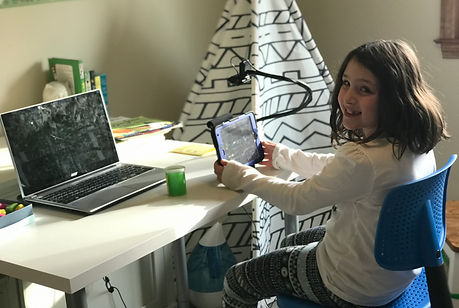Introduction to Tele-AAC
Module 2: Direct and Indirect Services via Tele-AAC

We now get to see tele-AAC in action.
Your learning objectives for this module are to:
-
list ways the arrangement of the equipment can support real-time interaction between the clinician and the individual or team member
-
detail the difference between direct and indirect tele-AAC services
-
define indirect tele-AAC services
The Tele-AAC Set-up
Module 1 provides an overview of tele-AAC. Module 2 shows us tele-AAC in action, helping to better illustrate this method of service delivery. Different elements of service delivery are shown in separate video clips.
Together in this first video, Nerissa and Alee demonstrate the clinician-client dynamic and the set-up for direct tele-AAC services. They show the way the AAC system, computer, and external camera are connected and positioned to support this real-time service.
Video 2.1
The Treating Clinician's Viewpoint
Now that Nerissa and Alee have shown the set-up at the location of the individual, in this next video Nerissa shows what it might look like at the location of the treating clinician. While she mentions specific technology used for the purposes of this demonstration, it is important to remember that this can be replicated with other tools and software.
Video 2.2
A Session in Action
We now get to see a session in action from Alee’s viewpoint in Video 2.3. Notice how Alee has items in her environment that support her engagement (such as putty). Nerissa introduces the session’s goal and models use of AAC providing a combination of verbal and visual prompting.
You can see how the set-up of the cameras (both the built-in and the external J-Mount) allow Nerissa to see where Alee is with respect to navigating her device, which, in turn, allows her to offer prompting and responses that are appropriately paced and supportive.
Video 2.3
A Back-and-Forth Perspective
In Video 2.4 we get to see what the direct tele-AAC intervention session looks like from both the side of the clinician and the individual using AAC. We go back and forth between their respective environments to get a better sense of what this real-time interaction looks like.
Notice how the set-up of the camera views helps simulate the interaction that may occur in an on-site environment. By having both the built-in webcam and the external webcam, Nerissa is able to pay attention to Alee’s nonverbal communication and her output from her AAC system. Alee is also able to communicate effectively using multi-modal communication.
Video 2.4
A Shift to Indirect Service Delivery
In this next part of Module 2 we switch from working directly with the individual to working indirectly with a team member. We get to see what indirect synchronous service delivery via tele-AAC looks like. Here Nerissa works with Alee’s dad to review programming a word into Alee’s device.
We can see in this example how it is just as important to be able to show AAC use, as it is to see it. This reiterates one of the defining features of tele-AAC and the need to have “eyes on the system” at the location of both the clinician and the client.
Video 2.5
A Clinical Adjustment
In this last video of Module 2 we get to see indirect services from the side of the clinician. As Nerissa is connecting directly with Alee’s dad (and regarding a skill that was already demonstrated and practiced) you will notice different pacing and language being used.
In addition, Nerissa is using a slightly different equipment set-up. Instead of showing how to program by screen-sharing her iPad, she is rather screen-sharing the camera view on her phone. This simulates a projector or document camera view. Now, rather than just seeing the screen change, Alee and her dad can see what Nerissa is selecting as her hand moves and interacts with the replicated AAC system.
Video 2.6
After you’ve watched the 6 videos of Module 2, think about:
-
Ways you can support an individual’s interest and engagement in a tele-environment?
-
How you can adjust the way you present material and information depending on your audience (i.e., an individual, or a family member with limited experience, or a team member with a lot of experience)?
-
What kinds of materials or games would lend themselves well to direct intervention environments?
Cancellation Policy: Commūnicāre, LLC reserves the right to cancel a class based on low registration. If a class is cancelled, participants will be notified and can either transfer their registration to another class or request a refund.
Refund Policy: Refunds will not be issued if a participant is unable to attend a class. However, registration may be transferred to another class, if available.
Complaint Policy: If you are not satisfied with the course you purchased, or have questions, comments or concern, please contact our Professional Development Coordinator.
